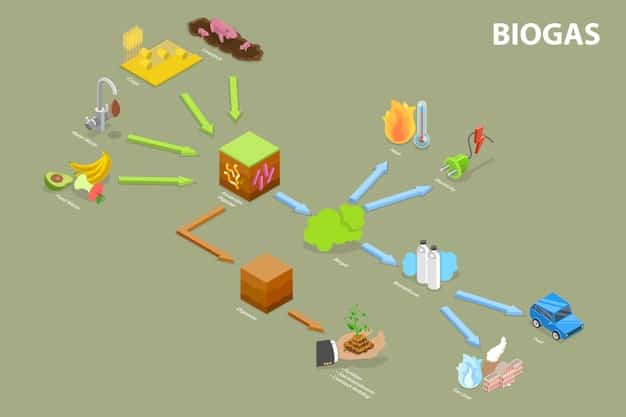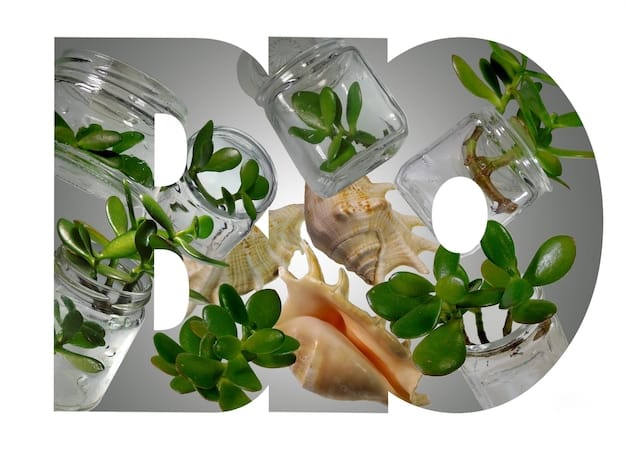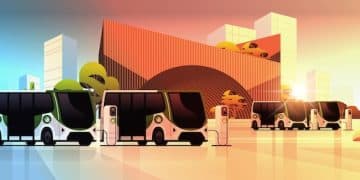Bioplastics in the US: Revolutionizing Industries by 2030

Bioplastics in the US are poised to disrupt traditional plastics by 2030, offering sustainable, plant-based alternatives that reduce environmental impact, enhance biodegradability, and align with circular economy principles.
The landscape of materials is on the cusp of significant transformation, and the rise of bioplastics in the US: Exploring the Potential of Plant-Based Polymers to Replace Traditional Plastics by 2030 represents a potent force for change. With growing environmental concerns and shifting consumer preferences, the shift towards sustainable alternatives is becoming increasingly critical.
Understanding Bioplastics: A Sustainable Alternative
Bioplastics represent a groundbreaking shift in material science, offering a sustainable alternative to traditional plastics. They are derived from renewable biomass sources, such as corn starch, sugarcane, and vegetable oils, contrasting sharply with conventional plastics made from fossil fuels.
What Defines a Bioplastic?
The term ‘bioplastic’ encompasses two key characteristics: bio-based and biodegradable. However, it’s important to note that not all bioplastics are biodegradable, and not all biodegradable plastics are bio-based. The defining factor is the origin of the material – if it’s derived from renewable sources, it qualifies as a bioplastic.
- Bio-based: Made from renewable resources, reducing reliance on fossil fuels.
- Biodegradable: Capable of being decomposed by microorganisms into natural substances like water, carbon dioxide, and biomass.
- Compostable: A subset of biodegradable plastics that can break down in specific composting conditions within a certain timeframe.
The environmental benefits of bioplastics are considerable. By using renewable resources, they reduce the carbon footprint associated with plastic production. Moreover, biodegradable bioplastics offer a solution to plastic waste accumulation, as they can break down naturally under the right conditions.

The US Bioplastics Market: Current State and Projections
The bioplastics market in the US is experiencing robust growth, driven by increasing consumer demand and supportive government policies. The current state of the market presents a diverse landscape of producers, manufacturers, and consumers, all contributing to the expansion of this sector.
Growth Drivers in the US Market
Several factors are fueling the growth of bioplastics in the US. Public awareness of environmental issues has led to a greater demand for eco-friendly products. Additionally, companies are increasingly seeking sustainable packaging solutions to meet corporate social responsibility goals.
- Consumer Demand: Growing preference for eco-friendly products and packaging.
- Corporate Sustainability Goals: Companies aiming to reduce their environmental footprint.
- Government Regulations: Policies promoting the use of renewable and biodegradable materials.
Projections for the bioplastics market by 2030 indicate significant expansion. Market analysis suggests that the bioplastics industry in the US will continue to grow at a substantial rate, driven by technological advancements and increasing adoption across various sectors.
Types of Bioplastics and Their Applications
Bioplastics encompass a wide range of materials, each with unique properties and applications. Understanding these different types is essential to appreciating the versatility and potential of bioplastics.
Common Types of Bioplastics
Several types of bioplastics are currently available, each derived from different renewable resources and possessing distinct characteristics. These include:
- PLA (Polylactic Acid): Derived from corn starch or sugarcane, PLA is commonly used in packaging, disposable tableware, and textiles.
- PHA (Polyhydroxyalkanoates): Produced by microorganisms, PHAs are biodegradable and can be used in a variety of applications, including packaging and medical devices.
- Starch Blends: Mixtures of starch with other biodegradable polymers, used in packaging and agricultural films.
These bioplastics find applications in various sectors, including packaging, agriculture, textiles, and healthcare. As technology advances, the range of applications for bioplastics continues to expand.

Challenges and Opportunities in Bioplastics Adoption
Despite their potential benefits, the widespread adoption of bioplastics faces several challenges. Addressing these challenges is crucial for realizing the full potential of bioplastics and paving the way for a more sustainable future.
Overcoming Hurdles in Bioplastics Implementation
One of the primary challenges is cost. Bioplastics are often more expensive to produce than traditional plastics, which can be a barrier to adoption. However, as technology improves and production scales up, costs are expected to decrease.
- Cost Competitiveness: Reducing production costs to compete with traditional plastics.
- Performance Limitations: Improving the durability and functionality of bioplastics for broader applications.
- Infrastructure Needs: Developing adequate composting and recycling infrastructure for bioplastics.
Opportunities for growth in the bioplastics sector are abundant. Investing in research and development, promoting public awareness, and implementing supportive government policies can all contribute to the widespread adoption of bioplastics.
Government Policies and Regulations Supporting Bioplastics
Government policies and regulations play a crucial role in fostering the growth of the bioplastics industry. Supportive policies can create a level playing field, incentivize innovation, and drive demand for sustainable materials.
The Role of Government in Promoting Bioplastics
Various policies can promote the adoption of bioplastics, including tax incentives, subsidies, and regulations mandating the use of renewable materials. Government procurement policies can also drive demand by favoring bioplastic products.
- Tax Incentives: Offering financial incentives for the production and use of bioplastics.
- Mandates: Requiring the use of bioplastics in specific applications.
- Research Funding: Investing in research and development to improve bioplastic technology.
Changes in regulations can significantly impact the adoption of bioplastics. Regulations that restrict the use of single-use plastics or promote composting can create a favorable environment for bioplastics.
The Future of Bioplastics in the Circular Economy
Bioplastics have the potential to play a central role in a circular economy, where materials are kept in use for as long as possible, reducing waste and minimizing environmental impact. Integrating bioplastics into circular economy models can transform the way we produce, use, and dispose of materials.
Bioplastics and Circular Economy Principles
By closing the loop on material flows, bioplastics can contribute to a more sustainable and resilient economy. Biodegradable bioplastics can be composted, returning valuable nutrients to the soil and reducing the need for virgin materials.
- Reducing Waste: Decreasing the amount of plastic waste sent to landfills.
- Conserving Resources: Utilizing renewable resources instead of fossil fuels.
- Promoting Innovation: Encouraging the development of new bioplastic technologies and applications.
The future of bioplastics looks promising, with ongoing research and development efforts focused on improving performance, reducing costs, and expanding applications. As environmental awareness grows and sustainability becomes a greater priority, bioplastics are poised to play an increasingly important role in shaping a more sustainable future.
| Key Point | Brief Description |
|---|---|
| 🌱 Sustainability | Bioplastics use renewable resources and reduce reliance on fossil fuels. |
| ♻️ Biodegradability | Certain bioplastics can decompose naturally, reducing plastic waste. |
| 📈 Market Growth | The US bioplastics market is growing due to consumer and corporate demands. |
| 🏛️ Policy Support | Government policies can incentivize bioplastic adoption through tax breaks and mandates. |
Frequently Asked Questions
▼
Bioplastics are primarily made from renewable biomass sources such as corn starch, sugarcane, vegetable oils, and other plant-based materials, reducing dependence on fossil fuels.
▼
No, not all bioplastics are biodegradable. Some are bio-based (made from renewable resources) but do not break down naturally. Others are both bio-based and biodegradable.
▼
Bioplastics are used in packaging (food containers, bags), agriculture (mulch films), consumer goods (electronics casings), and the medical field (surgical sutures, implants).
▼
Challenges include higher production costs compared to traditional plastics, performance limitations in certain applications, and the need for improved composting and recycling infrastructure.
▼
Government policies support bioplastics through tax incentives, subsidies, mandates for using renewable materials, research funding, and procurement policies favoring bioplastic products.
Conclusion
As the US strives for enhanced sustainability, bioplastics stand out as a viable and impactful solution to conventional plastic challenges. Embracing bioplastics not only reduces environmental harm but also fosters innovation and opens doors to a more ecologically conscious economy.





